General Government
![]()
The term Generalgouvernement (Polish: Generalne Gubernatorstwo) was initially used for the occupied Polish territories and initially referred to the territories of the former Second Polish Republic that were militarily occupied by the German Reich in 1939-1945 and not directly incorporated into the Reich territory by annexation, such as initially the new Reichsgaue Danzig-Westpreußen, Wartheland and the new administrative district of Zichenau in East Prussia. In addition, the term refers to the administrative structures established there under the governor general and NSDAP functionary Hans Frank and his deputy Josef Bühler, based in Krakow. The establishment of the Generalgouvernement was based on a decree by Hitler on October 12, 1939, and replaced the administration under the military commander-in-chief that had been in effect until then. It initially covered an area of 95,000 km² and was expanded to 144,000 km² on 1 August 1941, after the attack on the Soviet Union, to include the previously Soviet-occupied district of Galicia.
The German occupation of the Generalgouvernement combined a policy of exploitation and extermination. The Jewish and large parts of the Polish population were killed. Since no quick victory was to be expected in the East, a policy of exploitation was developed parallel to the extermination actions (extermination through labor), which was intended to compensate for the severe labor shortage in the German economy.
Economically, the Generalgouvernement was to be completely dependent on the Greater German Reich, while costing as little as possible. According to this concept, the Generalgouvernement represented a "loot" in terms of economic policy, which was to be plundered without regard to structural or longer-term connections of production and whose economy was to be turned into a "pile of rubble".
The Generalgouvernement was not to become a territory administered according to the German model, but was to remain in total disorganization. The occupation administration was to take care only of the immediate concerns of the occupiers themselves and leave the Poles to their fate.
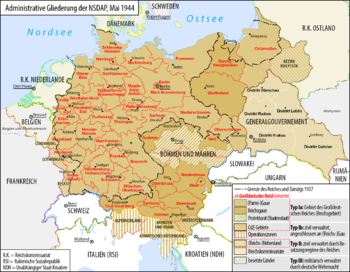
Structure of the Greater German Reich, May 1944
The General Government
After the successful war against Poland in the autumn of 1939, its military occupation followed; in doing so, the German occupiers basically distinguished between two territories: "Generalgouvernement für die besetzten polnischen Gebiete" ("General Government for the Occupied Polish Territories") was, from 26 October 1939, the designation for the so-called German Nebenland, i.e. the territories of the former Poland that had been occupied by National Socialist Germany during the Second World War but not incorporated into the German national territory. The designation "Generalgouvernement" was deliberately chosen in reference to the Generalgouvernement of Warsaw, which had been militarily administered by the German Empire during World War I (cf. Ober Ost). It contained the four districts of Krakow, Radom, Warsaw and Lublin, and since August 1, 1941 additionally Lemberg, had a total area of 142,000 km² with about 12 million inhabitants and existed until 1945.
In the Generalgouvernement, under Frank, an independent civilian occupation administration of the German Reich was installed, which replaced the military occupation, called the government. German rule in the Generalgouvernement is considered the most horrific manifestation of Nazi terror, against which the Polish Home Army formed despite, or perhaps because of, the brutal oppression. The hatred was vented in several uprisings, most of which were bloodily put down by the German occupiers. Among the best-known uprisings were the Warsaw Ghetto Uprising of spring 1943 and the Warsaw Uprising of August-October 1944. Some three million Polish Jews and almost as many Poles were murdered or fell victim to acts of terror (including the Przemyśl Massacre, so-called "Sonderaktionen" such as the Kraków Special Action) and the occupiers' deliberate starvation policies during World War II in the Generalgouvernement. Governor General Frank told a journalist in February 1940: "In Prague, for example, large red posters were posted saying that seven Czechs had been shot today. Then I said to myself: if I wanted to have one poster posted for every seven Poles shot, the forests of Poland would not suffice to make the paper for such posters."
The declared goal of the National Socialist occupiers was to make the Generalgouvernement "free of Jews" and to expel the Poles so that Germans could settle there. Then the Generalgouvernement was to be annexed. Governor General Frank stated at a department head meeting in Krakow on March 26, 1941:
"The Fuehrer has promised me that the Generalgouvernement will be completely cleared of Jews in the foreseeable future. Moreover, it has been clearly decided that in the future the Generalgouvernement will be a German living area. Where twelve million Poles live today, four to five million Germans are to live some day. The Generalgouvernement must become as German a country as the Rhineland."
The so-called Schmalzowniks played a particularly disastrous role in this plan.
The Poles were to be deprived of any possibility of independence; for example, the Polish high schools and universities had been closed and the educational and press systems had been cut back to a minimum in order to cement the oppression of the Slav population. A note by Reichsführer SS Heinrich Himmler states:
"A fundamental question in the solution of all these problems is the school question and with it the sifting and screening of the youth. For the non-German population of the East there must be no higher school than the four-class elementary school. The aim of this elementary school must be merely: simple arithmetic up to a maximum of 500, writing one's name, a teaching that it is a divine command to be obedient to the Germans, and to be honest, industrious, and well-behaved. Reading I do not consider necessary. Apart from this school, there must be no school at all in the East. [...] The population of the Generalgouvernement will then inevitably, after a consistent implementation of these measures, in the course of the next ten years, be composed of a remaining inferior population [...]. This population will be available as a leaderless labor force and will provide Germany with migrant workers and workers for special labor deposits (roads, quarries, buildings) every year."
Institution
With effect from 26 October 1939, in accordance with a law drawn up by the Reich Ministry of the Interior, the Generalgouvernement for the occupied Polish territories was placed under a civil administration and removed from the military administration of the Commander-in-Chief East, Gerd von Rundstedt. The establishment was abrupt and without consultation with the Wehrmacht. The historian Rolf-Dieter Müller sees a connection here with the criticism of the National Socialist policy of terror that Commander-in-Chief East General Johannes Blaskowitz had voiced. He now saw his leeway reduced to training replacement units for the Western Front and securing the border with the Soviet Union, but he knew this would secure him great influence in the Generalgouvernement.
Territorial delimitation
The Generalgouvernement comprised central Poland and bordered on the east on the German-Soviet division line on the Bug and San rivers, on the south on Hungary (Carpathoukraine) and the independent Slovak Republic formed six months earlier, and on the west and north on the German Reich (Prussian province of Silesia, later Upper Silesia, East Prussia and the Reichsgau Wartheland). The border with Slovakia had already been shifted in its favour on 21 September 1939 by the cession of the Polish Arwa-Zips region.
The official residence of Governor General Frank from Berlin was initially the city of Lodsch (Łódź). After its hasty incorporation into the German Reich on 9 November 1939, the Governor General moved his seat to the Wawel in Krakow from 26 October 1939.
From July 31, 1940, the Generalgouvernement for the occupied Polish territories used only the designation Generalgouvernement. The office of the Governor General in Krakow was now called the Government of the Generalgouvernement. The former heads of the districts were given the new designation of Governor. Governmental authority rested with the Governor General and the Chairman of the Council of Ministers for Reich Defense and Commissioner for the Four-Year Plan, Reichsmarschall Hermann Göring. In addition, Adolf Hitler authorized the highest Reich authorities to issue direct orders for the Generalgouvernement.
This also gave Heinrich Himmler and Reinhard Heydrich rights of intervention in the affairs of the Generalgouvernement. Subsequently, they achieved de facto sole jurisdiction through their executive organs, even though Frank resisted this.
During the advance of the Red Army, the Generalgouvernement was occupied up to the Vistula in the summer of 1944. The remaining parts west of the Vistula were conquered by the Red Army on its advance to the Oder River in the direction of Berlin in the Vistula-Oder Operation from 12 January 1945.
Legal status
The legal status of the Generalgouvernement remained unclear until 1945. It was usually referred to as "Nebenland" or Reichsnebenland, which was subject to the German exercise of power ("Raumhoheit"), but was not part of the Greater German Reich, so that it could be qualified as a foreign country. It was separated from the Reich by a police, currency, foreign exchange and customs border. Wilhelm Grewe, a National Socialist legal scholar at the time, noted that neither the debellation nor the occupation term was used in official pronouncements. From this he concluded that the categories of traditional international law oriented towards the concept of the state, such as state territory or ownerless territory, were no longer appropriate: "The Generalgouvernement is neither ownerless territory nor German Reich territory in the sense of state law".
Terror
The territory of the Generalgouvernement was covered with a dense network of concentration camps, where the SS-Totenkopfverbände and the Gestapo had unlimited power. There were work camps, camps for prisoners awaiting trial and prisoner-of-war camps, where the mortality of the inmates was particularly high. The Polish Jews were locked up in ghettos, the largest of which was the Warsaw Ghetto, established in October 1940. Here 450,000 Jews lived in inhumane conditions and were forced to work. In June/July 1941, Einsatzgruppen of the Security Police and the SD carried out the first large-scale mass murders of the Jewish population in the Generalgouvernement. From July 1942 to October 1943, the ghettos were liquidated as part of the Aktion Reinhardt extermination operation: two million Polish Jews and around 50,000 Roma were murdered in the four extermination camps of Belzec, Sobibor, Treblinka and Majdanek.
See also: History of the Jews in Poland
Forced Labor
Compulsory work for the Polish population
The Poles received only about 600 kilocalories a day. They were conscripted to forced labor in the Generalgouvernement on the basis of the Ordinance on the Introduction of Compulsory Labor for the Polish Population of the Generalgouvernement of October 26, 1939, or were also deported to areas outside of it in accordance with the Ordinance of Frank's Deputy Josef Bühler to Ensure the Need for Forces for Tasks of Special State Political Significance (the so-called Service Obligation Ordinance) of May 13, 1942. Children of forced laborers were taken to so-called child collection centers, which served the purpose of letting the children waste away unnoticed by the public. This was done primarily through systematic neglect and malnutrition. For example, the children in the Upper Austrian collection centre Spital am Pyhrn were given only half a litre of milk and three pieces of sugar every day.
Compulsory work for the Jewish population
With the decree on the introduction of compulsory labor for the Jewish population of the Generalgouvernement of October 26, 1939, compulsory labor was introduced with immediate effect for the Jews residing there. For this purpose, the obligated persons were grouped together in "forced labor squads". The regulations necessary for the implementation of this decree were not issued by the head of the Labor Department in the Office of the Governor General, who was responsible for the implementation of compulsory labor for the Polish population, but by the higher SS and police leader.
Administrative structure
The Governor General was exclusively and directly subordinate to Hitler; all branches of administration were assigned to him in sole responsibility. For the management of the administration he made use of the government of the General Government, to which the governors and, below them, the city and district captains were subordinate. The number of German administrative officials remained small, and the administration was based on colonial principles.
At both district and county level, all branches of administration were combined (unity of administration), so there was no room for special authorities.
The power to establish new law in the Generalgouvernement was vested in the President according to the law of October 12, 1939:
- the Council of Ministers for the Defense of the Reich,
- the commissioner for the four-year plan,
- the Governor General.
In Berlin, the "Plenipotentiary of the Governor General" was charged with establishing and promoting economic relations in particular.
The police of the Generalgouvernement was under the command of the Higher SS and Police Leader in Krakow (HSSPF), who, in addition to the State Secretary (Deputy Governor General), was directly subordinate to Governor General Frank. The Higher SS and Police Leader was at the same time the representative of the Reich Commissioner for the Consolidation of German Nationality. In order to retain at least some influence on the executive, Governor General Frank established the Sonderdienst, a kind of substitute police force made up of ethnic Germans that operated at the district level. Here, the polycracy typical of the Nazi regime became apparent, insofar as Frank, despite great efforts, did not succeed in gaining competence for the police and thus for the Volkstums- und Siedlungspolitik, which quickly became the dominant policy field in the Generalgouvernement.
Subordinate to him were the Commander of the Order Police and the Commander of the Security Police and the SD (BdS). These commanders and the Einsatzkommandos subordinate to them were essentially tasked with murdering primarily political opponents, communist functionaries and all people considered "racially inferior" ("Jews and Gypsies") in the "Eastern territories" to be conquered.
In each of the five districts there was an SS and police leader (SSPF).
The Wehrmacht forces deployed in the Generalgouvernement were subordinate to the Wehrmacht Commander in the Generalgouvernement under the Commander-in-Chief of the Army. A Fuehrer decree of 19 October 1939 established special rights of the Wehrmacht to safeguard military interests and in the event of internal unrest.
Territorial division
The General Government for the occupied Polish territories was initially divided into four districts: Krakow, Lublin, Radom and Warsaw, with the corresponding number of urban and rural districts.
After the beginning of the German-Soviet War, on August 1, 1941, the Soviet-Ukrainian area around Lemberg became part of the Generalgouvernement as the new district of Galicia with its seat in Lemberg. The district of Bialystok was not incorporated into the Generalgouvernement, but formed its own civil administrative district under the East Prussian Chief President Erich Koch on August 1, 1941.
While the boundaries of the districts were completely redefined, the former Polish boundaries were essentially retained with regard to the counties.
At the turn of the year 1939/1940, due to a lack of German personnel, several districts were combined into larger administrative units, which were given the designation "Kreishauptmannschaft" or "Stadthauptmannschaft". They were governed by German administrators (Kreis- or Stadthauptkommissars), a total of 130 functionaries from the Old Reich, such as Fritz Schwitzgebel.
The administration of the local rural communities (= collective communities with several village communities) was in Polish hands.
Change of urban counties:
- Krakow, Lublin, Radom, Czestochowa and Warsaw became city districts with the beginning of the German administration.
- On July 13, 1940, after incorporations into the parts of the city of Przemyśl west of the San that had remained German, the city district of Deutsch-Przemysl was formed, which until then had belonged to the district administration of Jaroslau. On November 15, 1941, after the incorporation of the eastern part of Przemysl, which had previously belonged to the district of Galicia, the district was renamed the city of Przemysl, which now became the administrative seat of the new district administration of Przemysl.
- On October 10, 1940, the Kielce Municipal District was established.
- On August 11, 1941, Lviv was confirmed as a city district.
Wehrmacht
With the establishment of the Generalgouvernement, Colonel General Blaskowitz took over as Commander-in-Chief East the military territorial command previously held by Rundstedt on 26 October 1939. He exposed himself by openly criticizing the policy of terror and nationalism in the Generalgouvernement, incurred Hitler's displeasure, and was replaced by Lieutenant General Curt Ludwig Freiherr von Gienanth in May 1940.
From the end of 1939, the planning and construction of large military training areas began. Tens of thousands of Poles had to be forcibly resettled for this purpose. The largest contiguous military training area complex, the southern military training area and the territorially contiguous SS military training area Heidelager, was built in western Galicia. It covered several hundred square kilometres. Furthermore, the large military training area Mitte was established near Radom. Other large military training areas of the Wehrmacht were the Rembertow military training area near Warsaw and the Reichshof military training area in southern Poland.
In the course of the deployment for "Unternehmen Barbarossa" on the territory of the Generalgouvernement, the military command was transferred to the highest command authority of the army. The military commander in the Generalgouvernement was also subordinated to it. This new designation had replaced the old Commander-in-Chief East in July 1940. Since then, the Generalgouvernement was considered an operational area of the Army only from an administrative point of view, and from September 1, 1942, it was otherwise considered a homeland war zone. Since then, the Generalgouvernement formed its own Wehrkreis, in which soldiers were drafted into the Wehrmacht. Gienanth was replaced by a Wehrkreis commander, General Siegfried Haenicke. On 11 September 1944, in accordance with the changed military situation, an Army District Generalgouvernement was established.
NSDAP
As Reichsleiter of the NSDAP, Frank headed the "Arbeitsbereich Generalgouvernement der NSDAP". This was subdivided into district site leaderships and sites (= local groups).
The NSDAP's Generalgouvernement Division maintained the "German Community", which included all Germans who were not members of the NSDAP, as well as all ethnic Germans. The "Volksdeutsche Gemeinschaft", founded on 20 April 1940, had been transferred to the "Deutsche Gemeinschaft" in May 1941.
Finance and economy
The Polish currency was retained in the Generalgouvernement; the rate was fixed at 2 Złoty to 1 Reichsmark. The notes of the former Bank Polski, founded in 1924, were exchanged in May 1940 by the new issuing bank in the Generalgouvernement, founded on 15 December 1939 (1 Złoty = 1 Złoty).
The Trusteeship Office in the Generalgouvernement, established on November 15, 1939, with its field offices in the district towns, administered both the confiscated assets of the Polish state, which from the German point of view had perished, and "private" Polish or Jewish assets.
The main source of income for the Generalgouvernement, however, were the monopolies, which were headed by Hermann Senkowsky from 1942. The Generalgouvernement was integrated into the National Socialist war economy, even if the Volkstumspolitik always had priority in case of conflict. Economically significant was the recruitment of forced laborers: By 1942, about one million Poles had already been taken from the Generalgouvernement to work in the German Reich.
The "work assignment" of the Polish and Jewish population was directed through the local employment offices. For the Polish population there was a duty to work and a restriction on changing jobs. For the Jewish population, work was compulsory.
From December 1, 1940, the Construction Service in the Generalgouvernement was responsible for important work in the field of national culture, the extension of transport lines or in cases of emergency. It was divided into the Polish Construction Service, the Ukrainian Homeland Service and the Goral Homeland Service.
Justice
Jurisdiction lay with the Higher SS and Police Leaders, who were subordinate to Himmler. Important cities in the Generalgouvernement had German courts and a German high court for each district. There was no head court - for example in Krakow. Furthermore, there were special courts, as in the German Reich.
In addition, Polish jurisdiction continued to exist. However, the Supreme Court was abolished and replaced by a court of appeal in each district location. These courts had to apply Polish law among Poles. In the event of a conflict, the German courts and German law took precedence.
Postal and telecommunications services were provided by the "Deutsche Post Osten". Its head (Richard Lauxmann from the end of October 1939 until January 1945) was based in Krakow. He was in charge of the district postal administrations and, under them, the superintendents of the individual post offices.
Deutsche Post Osten issued its own postage stamps. After Hindenburg medallion stamps provisionally overprinted with Polish currency denomination and "Deutsche Post Osten" were put into circulation in December 1939 and Polish stamps overprinted with "Generalgouvernement" in spring 1940, the first stamps specially designed for the occupied territories came to the counters in August 1940. Until autumn 1944, about 85 stamps for normal postal traffic (see stamp issues for the Generalgouvernement 1940, 1941, 1942, 1943 and 1944) and 36 official stamps were issued. The designers included Erwin Puchinger, Ferdinand Lorber and Wilhelm Dachauer.
The postage rates corresponded to those of the German Reich at the conversion rate 1 Pfennig = 2 Groschen.
From October 1943, the Generalgouvernement was integrated into the Reichsdeutsche system of postal codes. The postal code 7 a applied to the entire area.
Web
The new German railway directorate established during the invasion of Lodsch and the operational department advanced to Krakow from the Reichsbahndirektion Oppeln were united in Krakow on November 9, 1939 to form the "General Directorate of the Eastern Railway". This institution, called Gedob for short, had already been formally founded on 26 October 1939. That of the Ostbahn itself took place only on 27 November. The latter managed the Ostbahn via the Ostbahn-Betriebsdirektionen (since December 1940: Ostbahn-Bezirksdirektionen) Krakow, Lublin, Radom and Warsaw, which had taken over the railway network of the former Polish state railway PKP, but was not its legal successor. The operation was for the most part carried out by German railway personnel.
By the winter of 1939/1940, the destruction of the former Polish railway network had been removed to such an extent that German troops could be repatriated from the Bug and San by rail. In the spring of 1940 the railway lines were operational again except for some still missing bridge repairs.
After the conclusion of the German-Soviet economic treaty in the spring of 1940, the border crossings at Brest-Litovsk and Przemysl were considerably expanded. Efficient reloading stations were built there, since this is where the Russian broad gauge met the European standard gauge.
Since October 1940, the major west-east railway lines through the Generalgouvernement were restored and extended after war damage by the "Otto" programme, so that their transport capacity was multiplied. In particular, this concerned the railway line from Radom via Demblin to Lublin.
With the incorporation of the new district of Galicia on 1 August 1941, the new Eastern Railway District Directorate Galicia was established. However, this could only take over the route network from the Main Railway Directorate Kiev on 1 December 1941.
In the autumn of 1942, the Ostbahn-Bezirksdirektion Lublin was dissolved and its network was distributed among the directorates of Krakow, Radom and Warsaw. By decree of 8 March 1943, the Ostbahn-Bezirksdirektion Radom was also dissolved; as of 1 May, presidents were appointed for the three remaining directorates Krakow, Lemberg and Warsaw - which were now called "Ostbahndirektionen". For the rest, the full Reichsbahn organization was introduced. As the Red Army advanced, the Ostbahn offices were gradually relocated to the west in 1944/45, finally reaching the area north of Pilsen via Bayreuth in the spring of 1945.
Motor Transport
The distinguishing number for motor vehicles registered in the Generalgouvernement was "Ost". In front of this were the Roman numerals I to V for the districts of Krakow, Lublin, Radom, Warsaw and Galicia.
Germanization of place names
The Polish place names remained valid. The more important places, however, were given German names or names adapted to the German language.
By decree of September 15, 1941, the names of the following Polish towns were Germanized as of October 1, 1941:
District Krakow
| Jarosław | Yaroslav |
| Kraków | Krakow |
| Krzeszowice | Kressendorf |
| Lanckorona | Landskron |
| Łańcut | Landshut |
| Nowy Sącz | New Sandez |
| Nowy Targ | New Market (Dunajec) |
| Rzeszów | Reichshof |
| Stary Sącz | Alt-Sandez |
| Tarnów | Tarnau |
Lublin District
| Biała Podlaska | Biala-Podlaska |
| Biłgoraj | Bilgoraj |
| Chełm | Cholm |
| Janów Lubelski | Janow-Lubelski |
| Puławy | Pulawy |
Radom District
| Częstochowa | Czestochowa |
| Końskie | Konskie |
| Piotrków Trybunalski | Petrikau |
| Tomaszów Mazowiecki | Tomashov-Mazowiecki |
Warsaw District
| Grójec | Grojec |
| Łowicz | Lowitsch |
| Małkinia | Malkinia |
| Mińsk Mazowiecki | Minsk |
| Ostrów Mazowiecka | Ostrow |
| Sokolow | Sokolow |
| Warszawa | Warsaw |
City districts and district capitals 1944
District of Galicia
Governors of the District of Galicia:
- Karl Lasch (1 August 1941 to 6 January 1942, executed or suicide)
- Otto Wächter (22 January 1942 to July 1944)
City District
- Lviv
County Capitals
- Brzezany
- Czortkow
- Drohobycz
- Kamionka-Strumilova
- Kolomea
- Lviv County
- Rawa-Ruska
- Stanislau
- Stryj
- Tarnopol
- Zloczow
District Krakow
Governors of the Krakow District:
- Otto Wächter (26 October 1939 to 22 January 1942)
- Richard Wendler (31 January 1942 to 26 May 1943)
- Ludwig Losacker (26 May to 10 October 1943)
- Curt Ludwig Ehrenreich von Burgsdorff (23 November 1943 to 18 January 1945)
City District
- Krakow
County Capitals
- Debica
- Yaroslav
- Jaslo
- Krakow County
- Krosno
- Miechow
- New Sandez
- New Market (Dunajec)
- Przemysl
- Reichshof
- Sanok
- Tarnow
Lublin District
Governors of the Lublin District:
- Friedrich Schmidt (26 October 1939 to 1 February 1940)
- Ernst Zörner (1 February 1940 to 10 April 1943)
- Richard Wendler (from 26 May 1943)
City District
- Lublin
County Capitals
- Biala-Podlaska
- Biłgoraj
- Cholm
- Hrubieszów
- Krasnik
- Krasnystaw
- Lublin County
- Pulawy
- Radzyń
- Zamosc
Radom District
Governors of the Radom district:
- Karl Lasch (28 December 1939 to 1 August 1941)
- Ernst Kundt (1 August 1941 to 17 January 1945)
Urban counties
- Kielce
- Radome
- Czestochowa
County Capitals
- Busko
- Jędrzejów
- Kielce County
- Konskie
- Opatów
- Petrikau
- Radom Land
- Radomsko
- Starachowice
- Tomashov-Mazowiecki
Warsaw District
Governor of the District of Warsaw:
- Ludwig Fischer (26 October 1939 to 17 January 1945)
City District
- Warsaw
County Capitals
- Garwolin
- Grojec
- Lowitsch
- Minsk
- Ostrow
- Siedlce
- Sochaczew
- Sokolow
- Warsaw County
Baedeker's General Government
In 1943, a volume on the Generalgouvernement appeared in the Baedekers Reisehandbücher series. According to the publisher's preface, "the Governor General Reichsminister Dr. Hans Frank" had given the "suggestion for this new volume of our collection". In classic Baedeker style, the "Travel Guide" aims to inform about the "extent of the organizing and building work" of the German Reich in the occupied "Vistula region". The fact that this "construction work" included the organization and implementation of the expulsion and extermination of the Jewish population in this area was, of course, concealed in Baedeker's Generalgouvernenment 1943.
End of the General Government
The existence of the Generalgouvernement, which was created shortly after the beginning of the war, ended a few months before the overall German capitulation. The advancing Soviet troops reached the eastern border of the territory already in the spring of 1944. In the course of Operation Bagration, the Red Army advanced deep into German-occupied Poland: Lviv was taken on 27 July 1944; Lublin had been lost earlier on 24 July, where a Polish Communist government dependent on the Soviet Union was formed. After Soviet units began to cross the Vistula at the same time, the Warsaw Uprising began on August 1, which was put down by the Waffen-SS and other German troops after a few weeks.
By the end of 1944, most of the Generalgouvernement was occupied by the Red Army, and the Germans controlled only the western part of the area. Nevertheless, the Generalgouvernement was not dissolved, rather Frank and his administration remained in Krakow, which was only a few kilometers away from the front. The final collapse came with the Red Army's Vistula-Oder operation in January 1945. The German front could no longer withstand the onslaught, and so the occupied Polish territories were lost within a few days. On January 17 Warsaw was conquered, on January 19 the occupation capital Krakow. The day before Governor General Frank had already fled to Bavaria. This ended the existence of the Generalgouvernement.

Baedeker's Generalgouvernement . Karl Baedeker, 1943

Stamps Generalgouvernement

20 Złoty
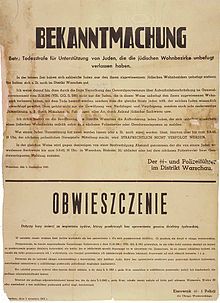
Executions for aiding escaped Jews (September 5, 1942)
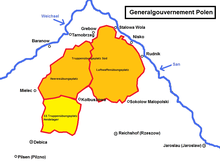
Military training area south

Territorial division of the Generalgouvernement (as of 1941)
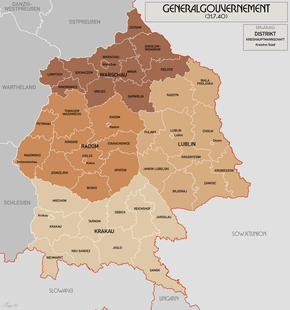
Territorial Division of the General Government (July 31, 1940)
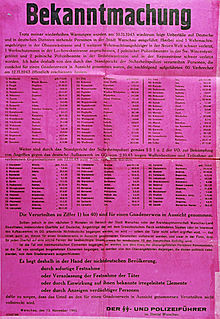
Executions and list of hostages with request to report suspects (denunciation), 1943
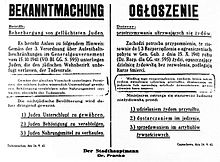
An announcement of the city captain Dr. Franke in Czestochowa of September 24, 1942
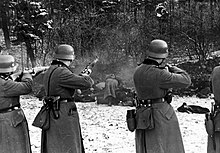
Massacre in Bochnia 1939
People
- Hans Frank, Governor General in Krakow 1939-1945
- Arthur Seyß-Inquart, Deputy Governor General 1939-1940
- Josef Bühler, Deputy Governor General 1940-1945
- Ernst Boepple, second State Secretary 1941-1945
- Theodor Bauder, Head of the Construction Department
- Friedrich Siebert, Head of the Administration Department
- Max Frauendorfer, Head of the Labour Department
- Hermann Senkowsky, Head of Finance Department
- Friedrich-Wilhelm Krüger, HSSPF, State Secretary until 1943
- Wilhelm Koppe, HSSPF, State Secretary as of 1943
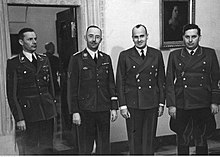
Krüger, Himmler, Frank, Bühler (1942)
Questions and Answers
Q: What is General Government?
A: General Government is a region in central Poland that was annexed from Nazi Germany in 1939.
Q: Was General Government a puppet state?
A: No, General Government was not a puppet state like Vidkun Quisling's Norway.
Q: What kind of administration did General Government have?
A: General Government had a semi-autonomous administration with local civil and military administration.
Q: Who staffed the local authorities in General Government?
A: The local authorities in General Government were staffed with Germans who were faithful to National Socialism.
Q: When did General Government become semi-autonomous?
A: General Government became semi-autonomous after its annexation from Nazi Germany in 1939.
Q: What was the role of the local authorities in General Government?
A: The local authorities in General Government were responsible for the civil and military administration of the region.
Q: What distinguishes General Government from Vidkun Quisling's Norway?
A: General Government was not a puppet state, unlike Vidkun Quisling's Norway.
Search within the encyclopedia